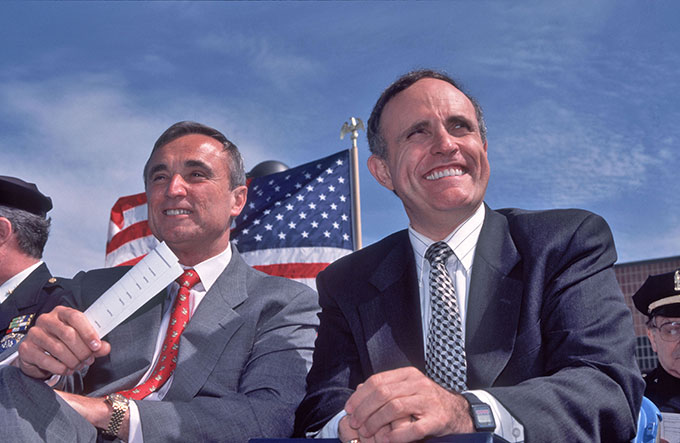New York’s Democratic Party establishment has been mugged by reality. Last November, after cycling through three police commissioners in as many years, Eric Adams appointed the competent and determined Jessica Tisch as the NYPD’s top cop. A strong advocate of the anti-crime strategies that powered the city’s renaissance beginning in the 1990s, Tisch has already overseen a drop in crime and has called on Albany to amend—or scrap altogether—the state’s ill-conceived criminal-justice reforms. She has pledged to reverse the decline in the NYPD’s ranks, which have fallen from over 40,000 in 2000 to fewer than 34,000 last year.
The commissioner’s success is largely founded on a return to the policing strategies, first deployed 35 years ago, that led to a remarkable reduction in crime.
Finally, a reason to check your email.
Sign up for our free newsletter today.
Flash back to 1990. That year, Mayor David Dinkins’s first in office, the city recorded 2,262 murders and logged more than 527,000 total crime complaints. Fed up with the violence, voters demanded reform. In 1991, at the behest of City Council Speaker Peter Vallone, Dinkins signed the landmark Safe Streets, Safe City law. The law raised taxes and used the new revenue to hire additional police officers. By 1993, the city had brought on 5,700 more cops, and crime levels began to drop. Murders fell below 2,000, and major crimes declined more than 15 percent from 1990.
Still, voters felt that progress was too slow and incremental, and they elected Rudy Giuliani to replace Dinkins in November 1993. Giuliani built on Dinkins’s Safe Streets, Safe City initiative and, over two terms, far exceeded its modest goals. Beginning in 1994, under the leadership of Commissioner William J. Bratton, the NYPD adopted “quality of life” policing, rooted in the Broken Windows theory of crime and public order. That same year, the department launched CompStat, a data-driven system that tracked crime by neighborhood and revolutionized the use of information analysis in policing strategies.
Crime in the city began to plummet. Over Giuliani’s first term, the number of murders fell by two-thirds, and the number of major crimes by more than half.
The change in the city’s fortunes was palpable to voters, and they reelected Giuliani in November 1997. In his second term, the NYPD continued to drive crime downward. The dramatic improvement in public safety continued further under Giuliani’s successor, Michael Bloomberg.
Commissioner Tisch represents a return to the policies that restored public safety in New York City. Like Dinkins and Vallone, she recognizes that the city cannot be effectively policed without enough officers. Like Giuliani and Bratton, she is using data to deploy resources to where they are most needed and can be most effective. Like her successful predecessors, Tisch has made clear that the city will not tolerate a “revolving door” system that imposes few consequences on repeat offenders. She has consistently called on the governor and the legislature to amend the state’s bail and discovery laws, which “have rendered the criminal justice system in New York City a high-speed revolving door for recidivists.”

Except for socialist Zohran Mamdani, the major mayoral candidates have essentially endorsed Tisch’s approach to public safety. This represents a remarkable turnabout from only five years ago, when many candidates supported defunding the police and reducing the number of uniformed cops. Now frontrunner Andrew Cuomo praises Tisch, saying that he’s “impressed” by the “very, very good job” she’s doing. In a promise he expressly ties back to Safe Streets, Safe City, Cuomo plans to hire 5,000 more cops. ‘“Defund the police’ are the three dumbest words ever uttered in politics,” he says.
In September 1990, the cover of Time featured a broken “I Love New York” heart with the headline, “The Rotting of the Big Apple.” Yet even with the city at its nadir, New York’s leaders, for all their flaws, refused to surrender to failure and chaos. Through well-spent revenue, they began to turn the tide on crime. Then, with Giuliani’s election, a transformation took place.
For those who witnessed the city’s rebirth in the Giuliani era, the memories of past success are indelible. With Commissioner Tisch’s assistance, the next mayor has a chance to rebuild the police force and redeploy the proven law-enforcement tactics that made New York one of the world’s safest cities.
Top Photo: NYPD Commissioner Jessica Tisch (Photo by Michael M. Santiago/Getty Images News via Getty Images)
City Journal is a publication of the Manhattan Institute for Policy Research (MI), a leading free-market think tank. Are you interested in supporting the magazine? As a 501(c)(3) nonprofit, donations in support of MI and City Journal are fully tax-deductible as provided by law (EIN #13-2912529).
Source link















